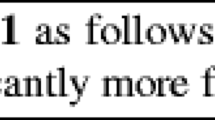Abstract
Thispaper aims at empirically exploring the relationships betweenmost of the existing design coupling, cohesion, and inheritancemeasures for object-oriented (OO) systems, and the fault-pronenessof OO system classes. The underlying goal of this study is tobetter understand the relationship between existing design measurementin OO systems and the quality of the software developed. in addition,we aim at assessing whether such relationships, once modeled,can be used to effectively drive and focus inspections or testing.The study described here is a replication of an analogous studyconducted in a university environment with systems developedby students. In order to draw more general conclusions and to(dis)confirm the results obtained there, we now replicated thestudy using data collected on an industrial system developedby professionals. Results show that many of our findings areconsistent across systems, despite the very disparate natureof the systems under study. Some of the strong dimensions capturedby the measures in each data set are visible in both the universityand industrial case study. For example, the frequency of methodinvocations appears to be the main driving factor of fault-pronenessin all systems. However, there are also differences across studies,which illustrate the fact that, although many principles andtechniques can be reused, quality does not follow universal lawsand quality models must be developed locally, wherever needed.
Similar content being viewed by others
References
Basili, V. R., Briand, L. C., and Melo, W. L. 1996. A validation of object-oriented design metrics as quality indicators. IEEE Transactions on Software Engineering 22(10): 751–761.
Belsley, D., Kuh, E., and Welsch, R. 1980. Regression Diagnostics: Identifying Influential Data and Sources of Collinearity. John Wiley & Sons.
Briand, L., Bunse, C., Daly, J., and Differding, C. 1997. An experimental comparison of the maintainability of object-oriented and structured design documents. Empirical Software Engineering 2(3). Also available as Technical Report ISERN–96–14.
Briand, L., Bunse, C., and Daly, J. 1997. An experimental evaluation of quality guidelines on the maintainability of object-oriented design documents. Proceedings of Empirical Studies of Programmers: Seventh Workshop (ESP 7). Also available as Technical Report ISERN–97–02.
Briand, L., Devanbu, P., and Melo, W. 1997. An investigation into coupling measures for C++. Proceedings of ICSE' 97. Boston, USA.
Briand, L., Daly, J., Porter, V., and W¨ust, J. 2000. Exploring the relationships between design measures and software quality in object-oriented systems. Journal of Systems and Software, 51:245–273. Also available as Technical Report ISERN–98–07.
Briand, L., Daly, J., and W¨ust, J. 1999. Aunified framework for coupling measurement in object-oriented systems. IEEE Transactions on Software Engineering, 25(1). Also as Technical Report ISERN–96–14.
Briand, L., Daly, J., W¨ust, J. 1998. A unified framework for cohesion measurement in object-oriented systems. Empirical Software Engineering Journal 3(1): 65–117. Also available as Technical Report ISERN–97–05.
Briand, L., Morasca, S., and Basili V. 1996. Property-based software engineering measurement. IEEE Transactions of Software Engineering 22(1): 68–86.
Briand, L., and W¨ust, J. 2001. The impact of design properties on development cost in object-oriented systems. Technical Report ISERN 99 16. Forthcoming in the proceedings of IEEE Metrics, London, England.
Bieman, J. M., and Kang, B.-K. 1995. Cohesion and reuse in an object-oriented system. Proc, ACM Symp. Software Reusibility (SSR' 94), 259–262.
Barnett, V., and Price, T. 1995. Outliers in Statistical Data. 3rd. Ed. John Wiley & Sons.
Chidamber, S. R., and Kemerer, C. F. 1991. Towards a metrics suite for object oriented design. A. Paepcke, (ed.) Proc. Conference on Object-Oriented Programming: Systems, Languages and Applications (OOPSLA' 91). Published in SIGPLAN Notices 26(11): 197–211.
Chidamber, S. R., and Kemerer, C. F. 1994. A metrics suite for object oriented design. IEEE Transactions on Software Engineering 20(6): 476–493.
Chidamber, S., Darcy, D., and Kemerer, C. 1998. Managerial use of metrics for object-oriented software: An exploratory analysis. IEEE Transactions on Software Engineering 24(8): 629–639.
Cartwright, M., and Shepperd, M. 1997. An empirical investigation of an object-oriented software: An exploratory analysis. Technical Report, Department of Computing. Bournemouth University, UK.
Dunteman, G. 1989. Principal Component Analysis. SAGE Publications. FAST Programmer's Manual. 1997. SEMA Group, France.
Henderson-Sellers, B. 1996. Software Metrics. Hemel Hempstaed, U.K.: Prentice Hall.
Hosmer, D. W. and Lemeshow, S. 1989. Applied Logisitc Regression. John Wiley & Sons.
Hitz, M., and 0Montazeri, B. 1995. Measuring coupling and cohesion in object-oriented systems. Proc. Int. Symposium on Applied Corporate Computing. Monterray, Mexico.
Khoshgoftaar, E., and Allen, E. 1997. Logistic regression modeling of software quality. TR-CSE–97–24. Florida Atlantic University.
Li, W., and Henry, S. 1993. Object-oriented metrics that predict maintainability. J. Systems and Software 23(2): 111–122.
Lake, A., and Cook, C. 1994. Use of factor analysis to develop OOP software complexity metrics. Proc 6th Annual Oregon Workshop on Software Metrics. Silver Falls, Oregon.
Lorenz, M., and Kidd, J. 1994. Object-oriented software metrics. Prentice Hall Object-Oriented Series. Englewood Cliffs, N.J.
Lee, Y.-S., Liang, B.-S., Wu, S.-F., and Wang, F.-J. 1995. Measuring the coupling and cohesion of an objectoriented program based on information flow. Proc. International Conference on Software Quality. Maribor, Slovenia.
Long, S. 1997. Regression models for categorical and limited dependent variables. Advanced Quantitative Techniques in the Social Sciences Series. Sage Publications.
Mayrand, J., and Coallier, F. 1996. System acquisition based on software product assessment. Proceedings of ICSE' 96. Berlin, Germany, 210–219.
Munson, J., and Khoshgoftaar, T. 1989. The dimensionality of program complexity. Proceedings of ICSE'89. Pittsburgh, 245–254.
Rosenberg, J. 1997. Some misconceptions about lines of code. Proceedings of the 4th International Software Metrics Symposium (Metrics' 97). 137–142.
Stone, M. Cross-validatory choice and assessment of statistical predictions. J. Royal Stat. Soc., Ser. B 36. 111–147.
Tegarden, D. P., Sheetz, S. D., and Monarchi, D. E. A software complexity model of object-oriented systems. Decision Support Systems 13(3–4): 241–262.
Author information
Authors and Affiliations
Rights and permissions
About this article
Cite this article
Briand, L.C., Wüst, J. & Lounis, H. Replicated Case Studies for Investigating Quality Factors in Object-Oriented Designs. Empirical Software Engineering 6, 11–58 (2001). https://doi.org/10.1023/A:1009815306478
Issue Date:
DOI: https://doi.org/10.1023/A:1009815306478




